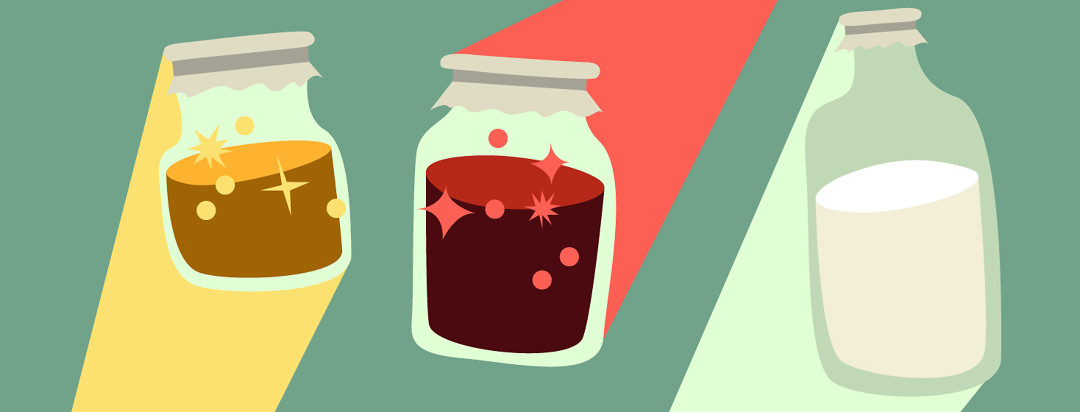Probiotic Drinks for Psoriasis
I’m always looking for ways to get probiotics into my diet. About 2 years ago I started making my own kombucha (fermented tea) and loved it so much that I started looking into other fermented beverages I could make at home. These fermented drinks can be expensive to buy in stores, but there’s no reason why you can’t make your own! Here are my top 3 probiotic drinks for psoriasis.
What is Kombucha?
Kombucha is the darling of the probiotic beverage family. Its origins are uncertain, but many cultures are known to have traditional recipes for fermented tea. Like most fermented beverages, kombucha is only slightly sweet, slightly fizzy, and can smell or taste like vinegar depending on how long the fermentation lasts. The fermentation is driven by a gelatinous pancake-looking blob called the SCOBY. SCOBY stands for Symbiotic Culture Of Bacteria and Yeast. It’s very difficult to grow from scratch, but with each fermentation, your SCOBY will grow a baby, so if you have friends or neighbors who brew their own kombucha you can start with a baby SCOBY from them.
How to make Kombucha
You can find lots of recipes online, but the general gist for making kombucha starts with making sugared black tea. You transfer your tea to a glass jar, add your SCOBY (wait for the tea to cool first), then cover the jar with cheesecloth, muselin, or a coffee filter; this prevents fruit fly attacks. Fermentation can take anywhere from 1 to 3 weeks, and the longer it goes the more vinegary and fizzy it gets. Some home brewers also like to do a second ferment after adding flavouring like fruit juices, ginger, mint, or other herbs. Take care not to brew your kombucha close to ripening fruit as it will slow down the fermentation.
If you’re worried about the sugar level in kombucha, take heart that the bacteria/yeasts are gobbling up most of the sugar that goes into the original brew.
What is Tepache?
If kombucha is the star child, tepache is the underestimated and overlooked second cousin. Tepache is fermented pineapple juice. This drink is popular in Mexico but has yet to catch on in the US or Canada; I’ll know when it has reached fandom levels when I can find it in the health food stores. Until then, pineapple tepache is easy to make at home.
How to make Tepache
Combine pineapple chunks, sugar water, and cloves, then cover with a cloth and let it ferment near a sunny window for three days. Unlike kombucha there is no SCOBY; instead, the natural bacteria and yeast present on the pineapple drive the fermentation. An important note is that you should leave the pineapple “skin” (or husk) on the chunks, as this is where those good bacteria/yeast live. Like kombucha, there are lots of great flavors you can add to your tepache brew… ginger and jalapenos are a great place to start!
If you find that you can’t get the fermentation going, don’t worry. Sometimes imported fruits have been sprayed to reduce microorganisms. In this case, you can add something called a “starter culture,” which usually comes as a powder containing inactivated bacteria/yeast. You can buy starter cultures online, or sometimes in health food stores.
What is Kefir?
I work in Toronto, Canada, and like many urban city centres we have all sorts of niche restaurants/grocers. Finding somewhere to indulge in the hottest food trends is easy. It was in Toronto that I got introduced to kefir, which is fermented milk. If you’re like me, the phrase “fermented milk” turns your stomach. Fermented milk may not sound appealing, but anyone who’s had a lassi in Asia knows just how delicious it is. Kefir drinks are often mixed with fresh blended fruit (like banana or mango), and are just slightly sour, and super refreshing.
Unlike kombucha and tepache, you don’t add any additional sugar to get the ferment going because the bacteria/yeast feed off the sugars already present in milk. While kombucha uses a SCOBY, and tepache uses natural microbes (or a starter), kefir uses “kefir grains.” Kefir grains often resemble cottage cheese or overcooked couscous. You can buy them online, or get them from a friend who is already brewing.
How to make Kefir
Like kombucha SCOBYs, kefir grains multiply with each ferment, so you only ever need to get them once! To make kefir, you add your kefir grains to milk, cover and leave in a warm spot for 24 hours to ferment. Kefir that’s ready has a consistency somewhere between milk and yogurt and has a pleasant aroma.
If you’re worried about creating sour milk that will upset your stomach (I mean, leaving milk out in a warm place intuitively feels wrong), consider joining one of the many online Facebook groups for home brewers. You’ll get lots of great tips from people already making their own!
So there you have it, three probiotic drinks that taste great and that you can make at home for very little money. Do you have any other favorite probiotic drinks? Maybe you’ve attempted to make your own kvass or kefir water? Let us know in the comments!

Join the conversation